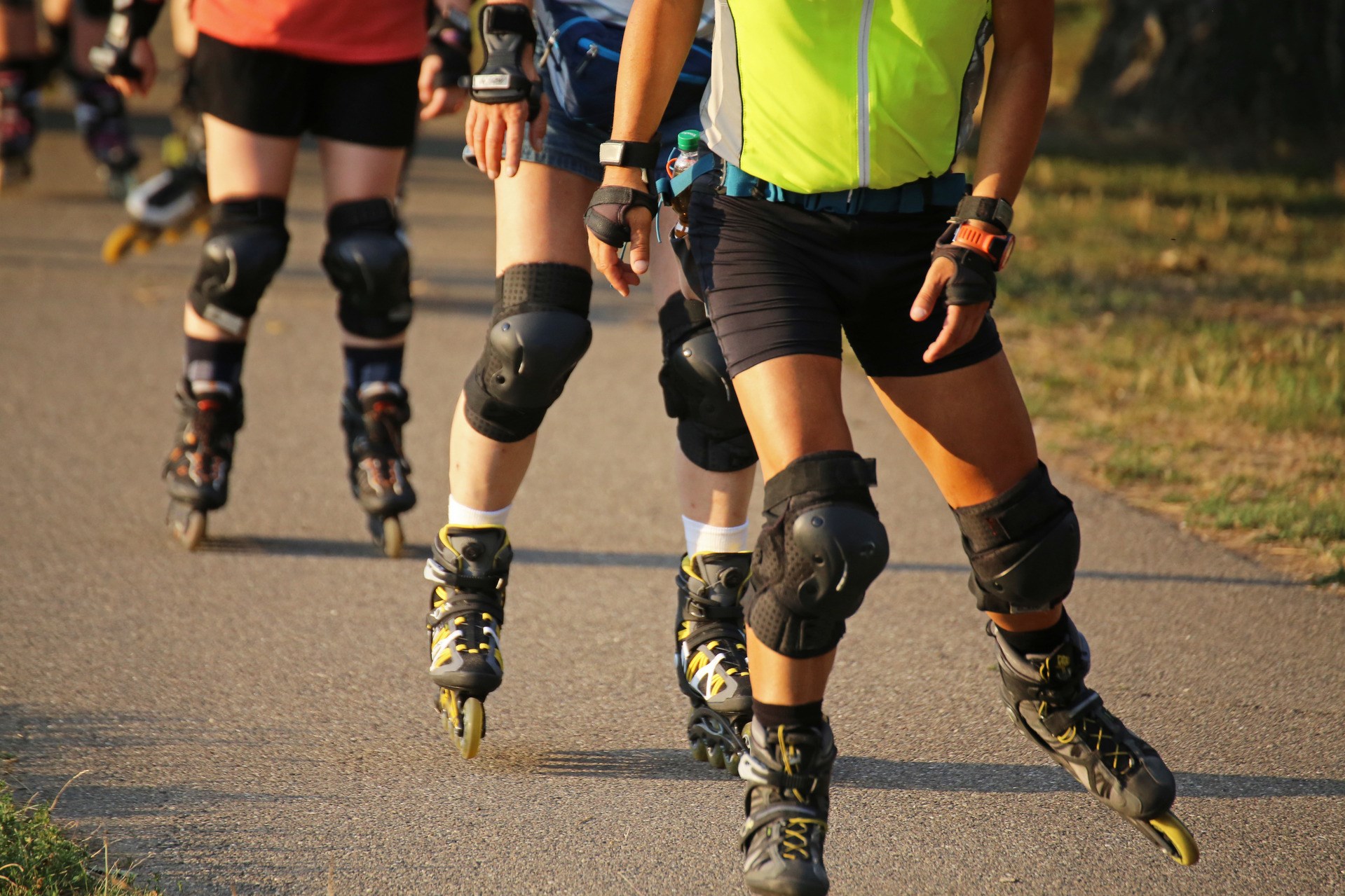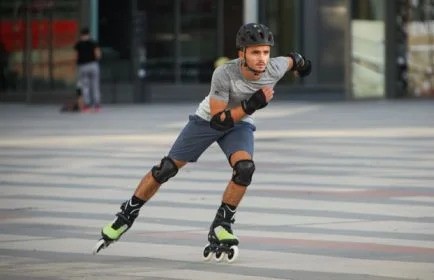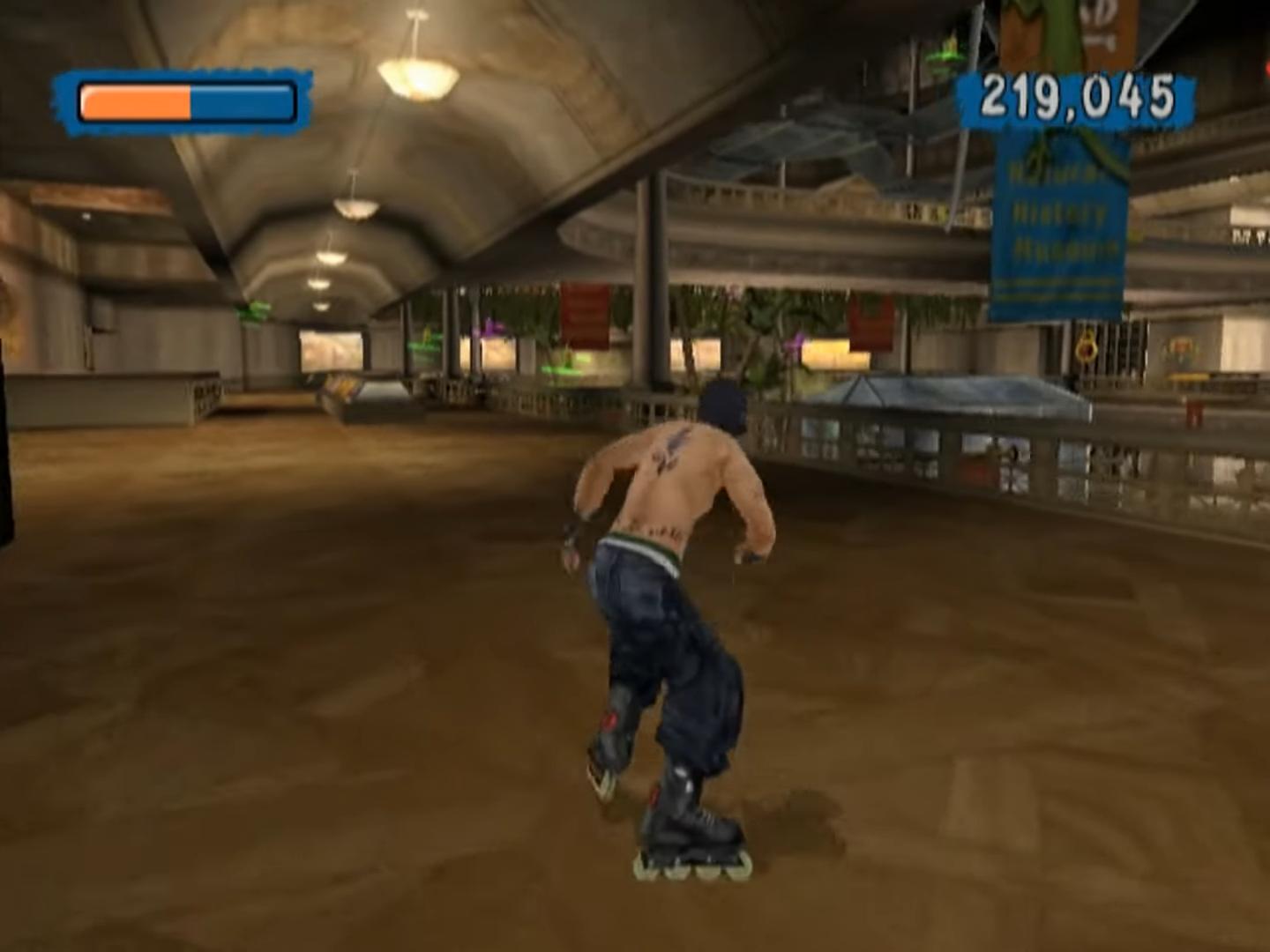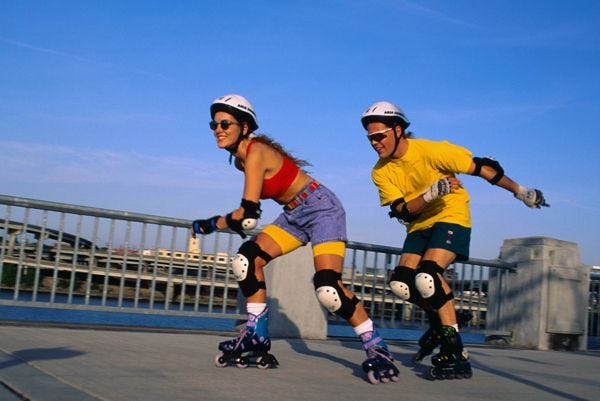Aggressive Inline Skating: Unleashing Thrills on the Edge
Dive into the adrenaline-fueled world of aggressive inline skating, where skaters defy gravity, execute daring tricks, and push the boundaries of precision and speed. From grinds to flips, this extreme sport melds creativity and skill, delivering an electrifying experience for participants and spectators alike.
Thrills and Tricks: The Art of Aggressive Inline Skating

In the dynamic realm of extreme sports, few activities match the raw intensity and artistic expression found in aggressive inline skating. With its roots deeply embedded in the freewheeling culture of skateboarding, this exhilarating discipline has evolved into a thrilling spectacle of skill, creativity, and adrenaline. From the thunderous clatter of wheels on rails to the weightless flight of a perfectly executed jump, aggressive inline skating is a fusion of precision and rebellion.
What are aggressive inline skates?
Aggressive inline skates are a specialized type of inline skates designed for performing tricks, stunts, and maneuvers in aggressive or freestyle skating. Unlike recreational inline skates, which are geared towards smooth rides and speed, aggressive inline skates are built for durability, flexibility, and the demands of skatepark and street skating. Here are some key features and characteristics of aggressive inline skates:
- Boot Design:
- Aggressive inline skate boots have a more robust and supportive design compared to recreational skates. They often feature high cuffs that provide additional ankle support, crucial for stability during jumps and landings.
- Soleplates and Grind Plates:
- Aggressive skates typically have replaceable soleplates and grind plates made of durable materials like plastic or metal. These components allow skaters to perform grinds on rails, ledges, and other surfaces without wearing down the boot.
- Frame Configuration:
- Aggressive inline skate frames are designed to be more responsive and maneuverable. Frames are often smaller in length to enhance agility, and they may be positioned closer to the center of the boot for better control during tricks.
- Wheels and Bearings:
- Aggressive skates use smaller, harder wheels to withstand the wear and tear associated with jumps, slides, and grinds. Harder wheels provide better durability on abrasive surfaces. Bearings are typically chosen for durability and ease of maintenance.
- Anti-Rocker Setup:
- Many aggressive skaters use an anti-rocker wheel setup, where the outer wheels are larger, and the inner wheels are smaller or replaced with solid grind wheels. This configuration enhances stability during grinds by reducing wheel contact with obstacles.
- Closure Systems:
- Aggressive inline skates often feature secure closure systems, such as buckles, straps, and laces, to ensure a snug fit and prevent any movement within the boot during intense maneuvers.
- Durability and Reinforcements:
- Aggressive skates are constructed with durability in mind. Reinforcements, such as extra padding, lace protectors, and abrasion-resistant materials, help the skates withstand the impact of tricks and jumps.
Who are the characters in aggressive inline?
Aggressive inline skating, being a sport and recreational activity, doesn't typically involve characters in the same way that fictional stories or video games do. However, there are prominent figures and athletes within the aggressive inline skating community who have gained recognition for their skills, contributions, and influence on the sport. These individuals are often professional aggressive inline skaters, known for their performances in competitions, video parts, and their impact on the culture of aggressive inline skating. Here are a few notable figures:
- Chris Haffey:
- Chris Haffey is widely regarded as one of the most influential and accomplished aggressive inline skaters. He has won multiple X Games gold medals and is known for his daring tricks and innovative style.
- Brian Aragon:
- Brian Aragon is a veteran in the aggressive inline skating community, known for his technical skills and versatility. He has been a consistent presence in competitions and has produced influential video parts.
- Franky Morales:
- Franky Morales is recognized for his smooth style and ability to perform technically challenging tricks. He has been a prominent figure in the aggressive inline scene for many years.
- CJ Wellsmore:
- CJ Wellsmore is an Australian skater known for his creativity and diverse skill set. He has competed at a high level and is often featured in various media showcasing his unique approach to skating.
- Julien Cudot:
- Julien Cudot is a French skater celebrated for his technical prowess and contribution to the progression of aggressive inline skating. He has been a consistent presence in international competitions.
- Megan Pugh:
- Megan Pugh is a standout female skater who has been a trailblazer in promoting gender inclusivity in aggressive inline skating. Her skills and passion for the sport have inspired many.
- Richie Eisler:
- Richie Eisler, originally from Australia, is known for his fluid and creative style. He has been influential in pushing the boundaries of what is possible on inline skates.
How do you size aggressive inline skates?
Sizing aggressive inline skates is crucial for comfort, performance, and safety while engaging in this dynamic sport. Here are the general steps to help you size aggressive inline skates:
- Measure Your Foot:
- Use a ruler or a foot measuring device to measure the length of your foot. Measure both feet, as they may not be exactly the same size. Take note of the measurement in centimeters or inches.
- Consider Skate Sizing Charts:
- Different brands may have slightly different sizing charts, so it's essential to consult the specific sizing chart provided by the manufacturer of the aggressive inline skates you're interested in. Skate sizes may not always correspond directly to your regular shoe size, so be sure to check the brand's recommendations.
- Choose the Right Size:
- Select a size that aligns with your foot measurement and the manufacturer's sizing chart. If you're between sizes, some skaters prefer to size down for a snug fit, while others prefer a bit of extra room for comfort. Keep in mind that aggressive inline skates often have a more precise fit than casual or recreational skates.
- Consider Liner Types:
- Aggressive inline skates usually come with liners that can be heat-molded to better conform to the shape of your foot. If the skates have heat-moldable liners, you may have some flexibility in achieving a more customized fit.
- Check for Width:
- Pay attention to the width of the skates, especially if you have particularly wide or narrow feet. Some brands offer different widths or liner options to accommodate different foot shapes.
- Consult Customer Reviews:
- Reading customer reviews and feedback can provide valuable insights into how a particular brand or model fits. Skaters often share their experiences with sizing and comfort, which can help you make an informed decision.
- Consider Sock Thickness:
- Keep in mind the thickness of the socks you plan to wear while skating. If you typically wear thicker socks, account for this in your sizing decision.
- Try Them On:
- If possible, try on the aggressive inline skates before purchasing. This allows you to assess the fit, comfort, and support firsthand. Ensure that your toes lightly touch the front of the skate without being cramped.
- Account for Break-In Period:
- New skates may require a break-in period as the liners and materials adjust to your feet. While it's essential for the skates to be snug, they shouldn't cause excessive pain or discomfort.
- Check Return Policies:
- Be aware of the return policies of the store or online platform where you purchase the skates. This ensures that if the skates don't fit well or meet your expectations, you have options for exchange or return.
How do you turn on aggressive inline skates?
Turning on aggressive inline skates involves a combination of body movements and weight distribution. Here are the basic steps to initiate turns:
- Bend Your Knees:
- Maintain a relaxed and slightly bent knee position. This helps you absorb shocks, stay balanced, and have better control over your skates.
- Look in the Direction You Want to Turn:
- Turn your head and look in the direction you intend to go. Your body tends to follow your gaze, so looking where you want to turn helps initiate the movement.
- Shift Your Weight:
- To turn left, shift your weight slightly to the left, and vice versa for turning right. Distribute your weight more on the foot opposite the direction you want to turn. For example, if you want to turn left, shift more weight onto your right foot.
- Use Your Ankles:
- Use your ankles to lean into the turn. Tilting your ankles in the direction of the turn allows the edges of your skates to engage with the surface, aiding in the turning process.
- Engage the Edges:
- Aggressive inline skates typically have a flat profile, but you can still engage the edges by leaning and tilting your feet. This allows you to turn more efficiently, especially at lower speeds.
- Practice Crossovers:
- Crossovers involve crossing one foot over the other during a turn. This technique is more advanced but can be effective for tighter turns and increased maneuverability.
- Start with Wide Turns:
- When learning to turn on aggressive inline skates, start with wide turns. This allows you to get a feel for the turning dynamics without the risk of losing balance during tight turns.
- Shift Your Hips:
- To enhance your turning ability, shift your hips in the direction of the turn. This contributes to a smoother and more controlled turn.
- Practice and Experiment:
- Turning on inline skates requires practice and experimentation. Spend time skating in open areas where you can safely practice turning in both directions. Experiment with different weight distributions and turning techniques to find what feels most comfortable for you.
- Mastering Tight Turns:
- As you become more confident, work on mastering tight turns. This involves sharper weight shifts and more precise ankle movements. Tight turns are essential for navigating obstacles and corners in aggressive inline skating.
How do I know my inline skate size?
Determining your inline skate size is essential for comfort, performance, and safety while skating. Here's a step-by-step guide on how to find your inline skate size:
- Measure Your Foot:
- Use a ruler, measuring tape, or a Brannock device to measure the length of your foot. Place your foot flat on the ground and measure from the heel to the tip of your longest toe. It's recommended to measure both feet, as one foot may be slightly larger than the other.
- Note the Measurement:
- Record the measurement in centimeters or inches. This is your foot length, which will serve as a reference when choosing inline skates.
- Consult the Sizing Chart:
- Different brands and models of inline skates may have slightly different sizing charts. Refer to the manufacturer's sizing chart provided on their website or product descriptions to determine the recommended size based on your foot length.
- Consider Skate Type:
- The type of inline skate you're considering (recreational, fitness, aggressive, etc.) may influence the sizing. Aggressive inline skates, for example, may have a more precise fit compared to recreational skates. Pay attention to any specific sizing recommendations provided for the type of skate you're interested in.
- Check for Width Options:
- Some inline skate models offer different width options. If you have particularly wide or narrow feet, consider models that provide width variations or liners that can accommodate different foot shapes.
- Review Customer Feedback:
- Read customer reviews and feedback, especially if you're purchasing online. Other skaters often share their experiences with sizing, providing insights into whether a particular model runs true to size or if adjustments need to be made.
- Consider Sock Thickness:
- Keep in mind the thickness of the socks you plan to wear while skating. If you typically wear thicker socks, account for this when selecting your inline skate size.
- Visit a Local Skate Shop:
- If possible, visit a local skate shop where you can try on different inline skate models and get assistance from knowledgeable staff. Trying on skates in person allows you to assess the fit and comfort before making a purchase.
- Check Return Policies:
- Be aware of the return policies of the store or online platform where you plan to purchase the inline skates. This ensures that if the skates don't fit well or meet your expectations, you have options for exchange or return.
- Consider Half Sizes:
- If your foot measurement falls between two whole sizes, some skaters prefer to size down for a snug fit, while others may opt for the larger size for a bit more room. This can depend on personal preference and the specific sizing recommendations of the brand.
How tight should inline skates be?
The tightness of inline skates is crucial for both comfort and performance. Here are some guidelines on how tight inline skates should be:
- Snug Fit:
- Inline skates should fit snugly around your feet without causing pain or discomfort. A snug fit ensures better control and responsiveness while skating.
- No Pressure Points:
- Pay attention to any pressure points or areas where the skates may be causing discomfort. Pressure points can lead to blisters or sore spots, so it's essential to address any issues with the fit.
- Heel Lock:
- Ensure that your heels are securely locked into the back of the skates. A secure heel lock prevents your feet from sliding inside the boots, enhancing stability and control.
- Toe Space:
- There should be a little space at the front of the skates for your toes. Your toes should lightly touch the front of the boot, but they should not be cramped or pressed against the front. This allows for proper balance and prevents the toes from hitting the front of the boot during stops or maneuvers.
- Ankle Support:
- Inline skates, especially those used for aggressive or freestyle skating, often have a higher cuff that provides ankle support. Ensure that the cuff is snug around your ankles, providing stability without restricting movement.
- Lacing:
- Use the lacing system effectively to achieve a secure fit. Tighten the laces from the bottom up, ensuring a consistent and even tightness. Some skaters prefer additional support around the ankle and may choose to lace the top portion more tightly.
- Buckle or Strap Tightness:
- If your skates have buckles or straps, adjust them to provide a secure fit without excessive pressure. Buckles and straps contribute to the overall stability of the skate.
- Consider the Type of Skating:
- The ideal tightness can also depend on the type of inline skating you're doing. Aggressive skaters may prefer a tighter fit for precise control during tricks, while recreational skaters might prioritize a balance between comfort and performance.
- Check for Movement:
- After lacing up your skates, check for any movement of your foot inside the boot. If your foot slides around too much, the skates may be too loose. However, if you experience pain or numbness, they may be too tight.
- Adjust During Break-In:
- Inline skates may require a break-in period, during which the materials adjust to the shape of your feet. If the skates feel slightly tight initially, they may become more comfortable after a few sessions.
How do you stop fast on inline skates?
Stopping quickly and effectively on inline skates is an essential skill for safety and control. There are several methods to stop on inline skates, and the choice of technique often depends on personal preference, skill level, and the type of skates you're using. Here are some common methods:
- T-Stop:
- The T-stop is a fundamental stopping technique that involves forming a "T" shape with your skates. Follow these steps:
- Bend your knees and shift your weight onto one leg.
- Extend the other leg to the side, creating a "T" shape with your skates.
- Apply gentle pressure on the stopping foot, using the wheels as a brake.
- Use your arms for balance, and gradually increase the pressure to slow down or come to a stop.
- The T-stop is a fundamental stopping technique that involves forming a "T" shape with your skates. Follow these steps:
- Power Slide:
- The power slide is a more advanced stopping technique that involves turning your skates perpendicular to your direction of motion. Here's how to perform a power slide:
- Shift your weight to one leg.
- Turn the other foot sideways, creating a 90-degree angle with your direction of travel.
- Use the outer edges of both skates to create friction and gradually come to a stop.
- Practice power slides in a controlled environment to improve your technique.
- The power slide is a more advanced stopping technique that involves turning your skates perpendicular to your direction of motion. Here's how to perform a power slide:
- Hockey Stop:
- The hockey stop is a quick stopping method commonly used in roller hockey. It involves making a controlled slide using both skates. Follow these steps:
- Bend your knees and lower your body.
- Turn both skates sideways to the direction of travel.
- Apply equal pressure on both skates, using the outer edges to create a controlled slide.
- Use your arms for balance and gradually increase the pressure to stop.
- The hockey stop is a quick stopping method commonly used in roller hockey. It involves making a controlled slide using both skates. Follow these steps:
- Parallel Slide:
- The parallel slide is a more advanced stopping technique that involves sliding both skates parallel to each other. Here's how to perform a parallel slide:
- Shift your weight slightly forward.
- Turn both skates sideways to create a parallel position.
- Apply pressure evenly on both skates to create a controlled slide.
- Use your arms for balance and gradually increase the pressure to stop.
- The parallel slide is a more advanced stopping technique that involves sliding both skates parallel to each other. Here's how to perform a parallel slide:
- Heel Brake:
- Some inline skates come equipped with a heel brake, a rubber stopper attached to the back of one skate. To use the heel brake:
- Shift your weight forward and lift the toes of your braking foot.
- Apply gradual and controlled pressure to the heel brake to slow down or stop.
- Practice using the heel brake in a safe and open space.
- Some inline skates come equipped with a heel brake, a rubber stopper attached to the back of one skate. To use the heel brake:
- Tight Turn and Spin:
- In certain situations, making a tight turn or spin can help you reduce speed quickly. These maneuvers involve using your body and leg movements to create controlled turns, dissipating speed in the process.
Practice stopping techniques in a controlled environment, gradually increasing your speed as you become more comfortable. It's crucial to wear protective gear, including a helmet, knee pads, elbow pads, and wrist guards, especially when practicing new stopping methods or skating at higher speeds.
How do you wear professional inline skates?
Wearing professional inline skates properly is essential for comfort, performance, and safety. Here are steps to guide you on how to wear professional inline skates:
1. Select the Right Size:
- Choose inline skates that are the right size for your feet. Refer to the sizing chart provided by the manufacturer to determine the appropriate size based on your foot measurements. Consider the type of skating you'll be doing, as different disciplines may have specific sizing preferences.
2. Wear Protective Gear:
- Before putting on your inline skates, wear appropriate protective gear, including a helmet, knee pads, elbow pads, and wrist guards. Protective gear is crucial for injury prevention, especially when learning new skills or skating at higher speeds.
3. Loosen the Laces:
- Loosen the laces on the inline skates to make it easier to slide your foot in. Ensure that the laces are evenly loosened from the toe to the top of the boot.
4. Open the Buckles and Straps:
- If your skates have buckles or straps, open them before attempting to put your foot in. This ensures that the skate is fully open and can accommodate your foot.
5. Slide Your Foot In:
- Slide your foot into the inline skate, ensuring that your heel is snugly seated in the back of the boot. Make sure your toes are positioned comfortably and not pressed against the front of the boot.
6. Adjust the Tongue:
- Adjust the tongue of the skate to ensure it is centered and covers the top of your foot. This helps distribute pressure evenly and provides a comfortable fit.
7. Lace Up:
- Begin lacing up your inline skates from the toe, ensuring that the laces are snug but not overly tight. Lace the skates all the way to the top, adjusting tightness as needed. Pay attention to any pressure points, and make sure the skates provide proper ankle support.
8. Secure Buckles and Straps:
- If your inline skates have buckles or straps, secure them to provide additional support and stability. Adjust the tightness of the buckles or straps based on your comfort level.
9. Check for Comfort:
- Once your inline skates are on and secured, check for overall comfort. Make sure your foot is securely in place, and there are no areas causing discomfort or pressure points. A snug fit is essential for control, but the skates should not be overly tight.
10. Stand Up and Walk Around: - Stand up and walk around to ensure that the skates feel secure and comfortable. Take a few strides to get a sense of how the skates perform and whether any adjustments are needed.
11. Practice Balancing: - Before hitting the road or skating surface, practice balancing on your inline skates in a controlled environment. This helps you get accustomed to the feel of the skates and improves your overall stability.
Aggressive inline skating is a dynamic and exhilarating sport that combines skill, creativity, and daring maneuvers on inline skates. From navigating urban landscapes to conquering skateparks, aggressive inline skaters showcase a diverse array of tricks, spins, and grinds, pushing the boundaries of what is possible on wheels. Key elements of this adrenaline-fueled activity include specialized equipment like robust boots with grind plates, smaller and harder wheels for durability, and frames designed for precise maneuverability.
Innovations in tricks and techniques continually define the aggressive inline skating scene. Skaters draw inspiration from various disciplines, contributing to a rich tapestry of moves that include airborne acrobatics, technical footwork, and the ever-evolving realm of grinds and slides. Competitions, collaborative community efforts, and the influence of technology through social media platforms contribute to the rapid progression of the sport.
Environmental considerations, such as the surfaces chosen for skating and the impact on public spaces, prompt skaters to balance their passion with respect for their surroundings. Additionally, safety measures, including protective gear like helmets and pads, play a crucial role in mitigating risks associated with the high-speed and intricate movements involved in aggressive inline skating.








